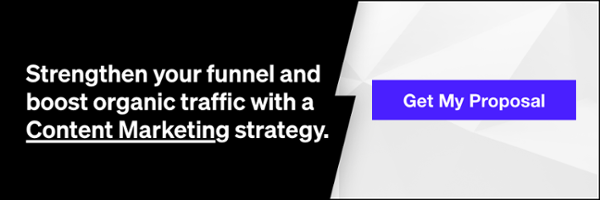Content for Consideration/Evaluation Stage

Buyers most likely will not convert after a single interaction with your brand. It takes some finessing, a little encouragement, and a lot of engagement with the buyer before your brand hits the consideration stage, much less the converting stage. How are you tracking your buyer’s journey? Are you?
Content marketing is effective if you are customizing it for the buyer’s journey. This means you have to get into your audience’s mindset, which you can do through analytics, A/B testing, and social listening. Through these marketing tactics, you can start identifying what content pieces they are engaging with the most. It can also help you track which campaigns have been most successful.
Related: How to Deliver Value at Every Stage of the Customer Journey
There are three main areas of a buyer’s journey for you to be mindful of: the awareness stage, the consideration or evaluation stage, and the decision stage. Providing value at the consideration stage helps to push them along the funnel and eventually convert.
Content for the consideration stage needs to provide your audience with the information they need to make a decision since they are researching before finalizing their purchase decision. This is your opportunity to show your expertise, consistency, and knowledge in the industry. You can’t just send your audience a “sign up” or “buy now” call-to-action without some context first. They want to get to know you better before deciding to commit.
You’re not likely to get a buy-in the first go around with a new prospect; so, how can you convince them you are the right choice? Provide the information they’re looking for at the time they need it. This can be done through multiple strategies but here are a few ideas you should add to your to do list, if you haven’t already.
Host A Webinar
Write down a list of topics that will bring your customers the most value. Glean insights from the data you already have through analytics, social reporting, and other tracking tools. Find which blog topics have been more popular in the past six months.
Check which emails have been opened most often. Ask your team what kind of questions their customers or clients are constantly asking. Group common themes in this data and create topics to continue delivering information about topics people enjoy most and answer questions to common problems your audience is experiencing.
This groundwork needs to be completed before you start your webinar to make it more successful. The point is to give your audience information they may not have had before. If it looks like you are unorganized or unsure of your topic, they are less likely to trust your authority on the subject and go elsewhere to find it.
Prior to your webinar date, make sure to give people ample opportunity to sign up and attend. Brand a hashtag that people can use on Twitter to ask questions and leave time at the end for Q&A. Following the webinar, send out the link of the recorded webinar and/or slides to your registered guests.
Publish A Case Study
Case studies are gold in any industry because it’s data that shows your product/service/company has been proven to work. Format your case study to outline the problem, strategy, and solution your team implemented to achieve successful results.
In the evaluation stage, customers are considering what you bring to the table. If there is no record of past successes (regardless of how many you’ve had), then the buyer may go to the next person who has documented their achievements.
Related: Beyond Blog Posts: 5 Ways to Take Your Content Strategy to the Next Level
Don’t miss this easy opportunity to add to your portfolio and also share as a content piece that can be used in an email campaign, blog post, and via your social media channels. A good case study will include statistics and metrics the user will easily understand.
Record A Demonstration Video
Sponsored content in the beauty vlogger world is a good example of where demo videos play well in the the consideration stage. When beauty bloggers record themselves trying out new makeup and skincare products, viewers see firsthand (sometimes even in real-time) how the product works, pros and cons, and what makes it worth buying.
This concept doesn’t have to be cornered by beauty bloggers alone. In most industries, buyers want to see how a product is going to work for them before purchasing. By recording a video that demonstrates how your product works in conditions relevant to your audience, it will entice the buyer to move through the funnel more quickly. Don’t just say “this product is for you” in this stage. Instead, say “this product is for you and let me show you why.”
Repurpose Your FAQ Page
You may already have an FAQ page on your website, which is valuable for the buyer but only if they know it’s there. However, how are you going to guide someone new to your brand to read through the answers to frequently asked questions, if they’ve never visited your site before or have forgotten it’s there?
Reiterate your FAQ questions in a blog and share on social media, stream them out one by one in an email series, and/or host a quick Q&A video chat to answer the questions people may have about your product. Remember a person in the consideration stage is seeking information. Don’t assume they are getting everything they need to know from your product descriptions or web copy.
Related: Building a Strong Content Marketing Plan & Strategy
Even if they’ve been to your FAQ page, are there other questions you can answer that have popped up over the years? Additionally, by incorporating the use of frequently asked questions in your online content, there’s a better chance it will rank in the search engines depending on the long-tail keywords you’re using. Think about it user behavior.
Users who are seeking answers and more insight are usually typing in their queries in question format. Wouldn’t it be useful for them if the answer to their query was provided in the first few results of Google? Wouldn’t it be even better if one of those first few results were yours?
Create A Comparison Chart
Track your competition and identify areas in which you excel; then compare. Decide which factors are most important to your audience. Quality, cost, and convenience are typical value propositions. How do you stack up against the competition in these areas? What other areas make you unique? A side-by-side comparison chart and guide will show how much value your product or service delivers and why it beats out the competition.
Offer A How-To Guide
Similar to the demonstration video, a how-to guide gives an in-depth of your product in action. It will help for people who’d rather consumer their content by reading than by watching a video. It can also serve as a complement to the video by acting as a step-by-step manual of how your product or service works.
Be creative in the type of how-to guides you create. For example, if your company sells sunglasses, your target buyer doesn’t need a guide on how to wear them. But they might be interested in content from a how-to guide for finding the right frame or style to fit their face.
Related: The Importance of Content Marketing: Mapping Out Integrated Campaigns
A tool manufacturer most likely doesn’t need to provide a guide for how to use a hammer. But a helpful how-to could be showing how to build a doghouse or bookshelf with the hammer. You get the idea.
Take a step back from what you’re selling to understand it from the other side. If you are the buyer, what kind of information would you want to know? What would persuade you to keep wanting more? The answers to these questions are what you need to use to create your content.
From Consideration To Buying
People have more choices now than ever before, which means your company not only has to stand out among the masses, you have to speak to your customer base at the right stage. Know your audience and the stage they’re in. Understand their needs and give them what they’re looking for most through your content.
In the consideration stage, they want to get all the information they can. They want to be sure when they spend their money on your product or service, it is going to be worthwhile. You aren’t likely to convince them on your first try, which means you have to show your consistency. Measure the results and optimize your content as needed.
Related: How to Measure the Success of Your Content Marketing Campaign
Also, consider the fact that not everyone will consume your content in the same way. Meaning that you can have 100 people in the evaluation stage and half of them may prefer to get their information through a webinar and reading case studies, while the other half may connect more with content from a demonstration video or infographic.
Be in tune with how your audience is consuming your content, where they are consuming your content (mobile or desktop, social media or blog posts, etc.), and how you are going to convince them at the consideration stage, that your company has what they need.
Our Editorial Standards
Reviewed for Accuracy
Every piece is fact-checked for precision.
Up-to-Date Research
We reflect the latest trends and insights.
Credible References
Backed by trusted industry sources.
Actionable & Insight-Driven
Strategic takeaways for real results.








